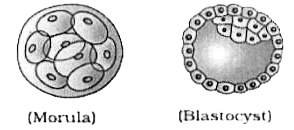The following is the illustration of the Transport of ovum, fertilisation and passage of growing embryo through fallopian tube.

Identify and draw the stages labelled 'e' and 'g'.
.e. is Morula, .g. is blastocyst (Correct diagram and name of stage)

Topper's Solved these Questions
- PRACTICE QUESTION PAPER-2BOOK - CBSE COMPLEMENTARY MATERIALCHAPTER - PRACTICE QUESTION PAPER-2EXERCISE - SECTION C
21 Videos
- PRACTICE QUESTION PAPER - 1 BOOK - CBSE COMPLEMENTARY MATERIALCHAPTER - PRACTICE QUESTION PAPER - 1 EXERCISE - SECTION A
2 Videos
- PRINCIPLES OF INHERITANCE AND VARIATIONBOOK - CBSE COMPLEMENTARY MATERIALCHAPTER - PRINCIPLES OF INHERITANCE AND VARIATIONEXERCISE - QUESTIONS (LA)
3 Videos
Similar Questions
The following is the illustration of the Transport of ovum, fertilisation and passage of growing embryo through fallopian tube.

How is placenta formed?
View SolutionThe following is the illustration of the Transport of ovum, fertilisation and passage of growing embryo through fallopian tube.

What are the roles of cells present in stage 'g'?
View SolutionThe following is the illustration of the Transport of ovum, fertilisation and passage of growing embryo through fallopian tube.

Name the process represented by 'H' and the layer of maternal tissue involved in it.
View SolutionThe following diagram shows transport of ovum, fertilisation and passage of growing embryo. Choose the option that correctly identifies one of the stages and its characteristic.

View SolutionThe following is the illustration of the sequence of ovarian events (a - 1) in a human female. (a) Identify the figure that illustrates ovulation and mention the stage of oogenesis it represents.
(b) Name the pituitary hormone that has caused the above mentioned event.
(c) Explain the changes that occur in the uterus simultaneously in anticipation
(d) Write the differences between 'c and 'h'.
(e ) Draw a labelled sketch of the structure of a human ovum prior to fertilization.

View SolutionThe following is the illustration of the sequence of ovarian events (a - 1) in a human female. (a) Identify the figure that illustrates ovulation and mention the stage of oogenesis it represents.
(b) Name the pituitary hormone that has caused the above mentioned event.
(c) Explain the changes that occur in the uterus simultaneously in anticipation
(d) Write the differences between 'c and 'h'.
(e ) Draw a labelled sketch of the structure of a human ovum prior to fertilization.

View SolutionThe following is the illustration of the sequence of ovarian events (a - i) in human female.

(i) Identify the figure that illustrates ovulation and mention the stage of oogenesis it represents.
(ii) Name the ovarian hormone and the pituitary hormone that have caused the above mentioned event.
(iii) Explain the changes that occur in the uterus simultaneously in anticipation.
(iv) Write the difference between 'c' and 'h'
(v) Draw a labelled sketch of the structure of a human ovum prior to fertilization.
View SolutionThe following is the illustration of the sequence of ovarian events ''a'' to ''I'' in a human female :

(a) Identify the figure that illustrates corpus luteum and name the pituitar) hormone that inhuences its formation.
(b) Specify the endocrine function of corpus luteum. How does it influence the uterus? Why is it essential?
(c) What is the difference between “d” and “e”?
(d) Draw a neat labelled sketch of Graafian follicle.
View SolutionThe following is the illustration of the sequence of ovarian events ''a'' to ''I'' in a human female :

(a) Identify the figure that illustrates corpus luteum and name the pituitary hormone that inhuences its formation.
(b) Specify the endocrine function of corpus luteum. How does it influence the uterus? Why is it essential?
(c) What is the difference between “d” and “e”?
(d) Draw a neat labelled sketch of Graafian follicle.
View SolutionDraw a well-labelled diagram of L.S of a pistil of a flower showing the passage of growing of pollen tube up its destination
View Solution
